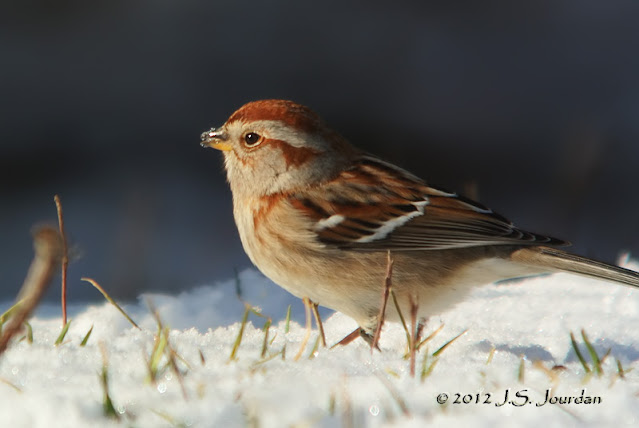Digiscoping w/ the new Nikon V1 - 26 Feb 2012
In my search for a new digiscoping camera I decided to look at the wonderful offerings from the 4/3 or mirrorless formats. A number of great cameras are out there, but the most important requirement would be whether the camera 'could' be used w/ my Zeiss 85T*Fl and 20-60X or 45X eyepieces.
A trip to Best Buy in December shortened the list considerably. I'd been really turned on by the Panasonic G2/G3/GH2 w/ the 14-42 mm internal focusing lens. Sadly, I could not eliminate vignetting at any focal length w/ my eyepieces. The Sony Nex 5/Nex 7 are probably the finest cameras in the bunch w/ superior image quality and noise capabilities, but I'd have to invest in lenses that 'might' be compatible w/ my scope - no luck. I struck out w/ the Olympus Pen cameras, as well. I had a play w/ the Nikon J1 (the V1's little brother/sister) and found that the 10-30 mm lens worked wonderfully in the store. The camera also boasted a 10 fps continuous frame rate, but is a fully-automatic camera w/o the ability to shoot in Manual or Aperture-priorities.
The Nikon V1 has had a very storied introduction into the world of mirrorless cameras. When first announced by Nikon the camera was quickly 'destroyed' by the pixel-peepers and 'experts' that frequent the camera bulletin boards. "The sensor is too small". "The camera lacks usable function buttons". "Its too simple". "It has no bells and whistles". And so on... When the camera hit the market, however, the grumblers and haters were quickly silenced. Folks like Rob Galbraith and others (Nasim Mansurov, DxO Labs, Steve Huff) gave very positive reviews, and were able to finally show some outstanding photos from the camera that Nikon failed to provide during their advertising campaigns. Neil Pfifer, a well-know digiscoping pioneer, was probably the first person to try the camera for digiscoping and, as usual, was able to make it sing! His images, and others to follow, convinced me that my next camera could be a winner.
The morning sun was still low, and the bird was side-lit, but the camera quickly (apparently the V1 has one of the fastest autofocus capabilities of any camera, including DSLR's) and easily focused on the bird. I set the camera to auto-adjust ISO between 100-400 and shot Aperture-priority*. I needed to adjust Exposure Compensation to -1.0 or so to avoid blown highlights.
Other digiscopers are quickly jumping on the band wagon w/ this camera. Check out the Digiscoping forum in Facebook and you'll see some wonderful images from other birders around the globe.
I made a quick run over to Haagerman Rd. and found a pair of Northern Harriers (male and female) and another 2 Red-tailed Hawks working the fields. Horned Larks were singing and flying about, but I did not see any longspurs or buntings. It was great running into Pat Gamburd, and we chatted a bit before I headed home.
Pte. Mouillee SGA--HQ, Wayne, Michigan, US
Feb 26, 2012 9:00 AM - 9:30 AM
Protocol: Stationary
Checklist Comments: Breaking in a new Nikon P6000 for digiscoping. Cold, clear, snow on ground.
10 species
Northern Harrier (Circus hudsonius) 2
Bald Eagle (Haliaeetus leucocephalus) 1
Red-tailed Hawk (Buteo jamaicensis) 1
Black-capped Chickadee (Poecile atricapillus) 4
Horned Lark (Eremophila alpestris) 6 Haggerman Rd.
American Tree Sparrow (Spizelloides arborea) 2
Dark-eyed Junco (Junco hyemalis) 2
White-throated Sparrow (Zonotrichia albicollis) 2
Red-winged Blackbird (Agelaius phoeniceus) 3
Northern Cardinal (Cardinalis cardinalis) 2
View this checklist online at https://ebird.org/checklist/S1
This report was generated automatically by eBird v3 (https://ebird.org/home)
Final word? The Nikon V1 is gonna be a smash among digiscopers, and may quickly become the camera of choice. I can't wait to give a more extensive workout when I head to Sedona, AZ this week. There I plan to put it through its paces, and do a more formal comparison w/ the Coolpix P6000. Stay tuned!
* - The camera auto-adjusts aperture based on focal length, so it needs to be adjusted if you want faster shutter speeds.
** - Although the camera shoots RAW, Adobe Raw Conversion is only compatible w/ Photoshop CS5, so I'm unable to process the files at this time w/ CS2. Photoshop Elements users need version 10.0(?).
Feb 26, 2012 9:00 AM - 9:30 AM
Protocol: Stationary
Checklist Comments: Breaking in a new Nikon P6000 for digiscoping. Cold, clear, snow on ground.
10 species
Northern Harrier (Circus hudsonius) 2
Bald Eagle (Haliaeetus leucocephalus) 1
Red-tailed Hawk (Buteo jamaicensis) 1
Black-capped Chickadee (Poecile atricapillus) 4
Horned Lark (Eremophila alpestris) 6 Haggerman Rd.
American Tree Sparrow (Spizelloides arborea) 2
Dark-eyed Junco (Junco hyemalis) 2
White-throated Sparrow (Zonotrichia albicollis) 2
Red-winged Blackbird (Agelaius phoeniceus) 3
Northern Cardinal (Cardinalis cardinalis) 2
View this checklist online at https://ebird.org/checklist/S1
This report was generated automatically by eBird v3 (https://ebird.org/home)
Final word? The Nikon V1 is gonna be a smash among digiscopers, and may quickly become the camera of choice. I can't wait to give a more extensive workout when I head to Sedona, AZ this week. There I plan to put it through its paces, and do a more formal comparison w/ the Coolpix P6000. Stay tuned!
* - The camera auto-adjusts aperture based on focal length, so it needs to be adjusted if you want faster shutter speeds.
** - Although the camera shoots RAW, Adobe Raw Conversion is only compatible w/ Photoshop CS5, so I'm unable to process the files at this time w/ CS2. Photoshop Elements users need version 10.0(?).


















Thanks for sharing the wonderful pictures and thoughtful review of the V1. I have been looking for a new digiscoping camera and your comments and those of others using it have convinced me I should definately look at it. Love your blog!
ReplyDeleteThanks for posting your inaugural digiscoping adventure with the V1. The images are fabulous. I look forward to seeing more images as the spring marshes blossom with migratory birds.
ReplyDelete